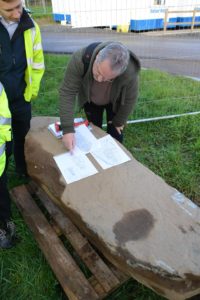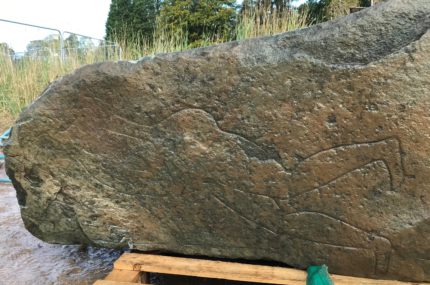Pictish stones are usually abstract designs or animal figures that are stylized enough to look abstract to the untrained eye. That’s why they’re known as “symbol stones,” and why even experts don’t know what all of the symbols recorded from the 350 or so known Pictish stones represent. One theory is that they could be a sort of proto-heraldic assemblage identifying these large, imposing standing stones as the mark an important local family.
 Roadwork on the A9/A85 highway in Perth, Scotland, has unearthed a Pictish Symbol Stone in which the symbol is a man, not a V-notch, not a circle, not something that could be an eagle if you squint at it long enough, but a clear outline drawing of a man carrying a spear in his right hand and a club or staff in his left. He is large and physically imposing and while he is wearing a cloak and shoes, the clothing is kept to a minimum in such a manner to emphasize his powerful glutes and quads. He is also sporting an unusual hairstyle: the front, and only the front, of his scalp is shaved. Other facial features have worn away, but from what little is left, it seems his nose was large and in charge.
Roadwork on the A9/A85 highway in Perth, Scotland, has unearthed a Pictish Symbol Stone in which the symbol is a man, not a V-notch, not a circle, not something that could be an eagle if you squint at it long enough, but a clear outline drawing of a man carrying a spear in his right hand and a club or staff in his left. He is large and physically imposing and while he is wearing a cloak and shoes, the clothing is kept to a minimum in such a manner to emphasize his powerful glutes and quads. He is also sporting an unusual hairstyle: the front, and only the front, of his scalp is shaved. Other facial features have worn away, but from what little is left, it seems his nose was large and in charge.
There is no precise date for the stone as of yet. The spear he carries is of a type used in the middle of the 1st millennium A.D., which is a broad enough range to not tell us a great deal. If it’s actually 500 A.D., that is early for Pictish stones. There are no known Pictish sites in the area, which makes the discovery of this stone all the more significant. It may even refer to a specific local potentate.
A spokesperson for Perth and Kinross Council said: “The fearsome figure probably served to warn travellers and visitors that they were approaching his residence or territory.
“The study of the carving and what it can reveal about life in Pictish Scotland will continue. The Scottish Treasure Trove has been notified and the carving will be allocated to a museum in due course.
“After an inspection of the find spot, no further archaeological works were considered necessary and the roadworks have resumed.”
Mark Hall of the Perth Museum and Art Gallery was called in to the worksite when the stone was discovered. He documented it thoroughly in situ before it was removed and roadwork continued. The stone is now being kept at a mysterious undisclosed location where it will be studied and conserved while the Treasure Trove committee revs into gear and makes the decision everyone knows it’s going to make anyway. Obviously the ancient stone will be declared treasure. Then the only question is which museum will get to keep it.

I wonder whether “Pict” to a Roman meant a Briton whose culture showed no Roman influence. Thus Britons north of the Scottish midland valley, or in the far SW of Scotland, would be Picts. This notion might explain why St Ninian was known as Apostle to the Picts even though his base was in Whithorn in Wigtonshire, far from the territory usually described as Pictish.
https://en.wikipedia.org/wiki/Whithorn
The fore part of the skull, shaved ear to ear, was usually the mark of Celtic priests and druids. Rome had a big disagreement with Patrick over his use of that tonsure.
That “apostles” had bases, (more or less) far from those they were sent to on a ‘mission’, comes actually not totally unexpected. Apart from that, there is quite a lot of Greek and Roman authors describing Britain and its wild inhabitants. A description from around 98 AD:
————-
“Ceterum Britanniam qui mortales initio coluerint, indigenae an advecti, ut inter barbaros, parum compertum. Habitus corporum varii atque ex eo argumenta. Namque rutilae Caledoniam habitantium comae, magni artus Germanicam originem adseverant; Silurum colorati vultus, torti plerumque crines et posita contra Hispania Hiberos veteres traiecisse easque sedes occupasse fidem faciunt; proximi Gallis et similes sunt, seu durante originis vi, seu procurrentibus in diversa terris positio caeli corporibus habitum dedit. In universum tamen aestimanti Gallos vicinam insulam occupasse credibile est.”
“Ceterum, … about which kind of mortals were the first to live in Britania, indigenous ones or settlers, little is known, as it is often the case with Barbarians. Their physical habitus varies, and from that conclusions may be drawn. That is to say, the reddish-blonde hair and large limbs of the inhabitants of Caledonia point to a German origin. The dark complexion of the Silures, their curly and thick hair, and that Spain is on the opposite shore, hint at Iberians that crossed over at a former date and occupied those parts. Nearest [to the British], and similar to them, are the Gauls, either from a permanent influence of orgine, or, in countries that run out so far, the climate produced similar physical qualities. In general, however, it is fair to assume that Gauls occupied the island next to them.”
————-
As there are no typical ‘Pictish’ abstract designs or animal figures, I would personally not be able to differ a ‘Celtic’ stone from a ‘Pictish’ or a ‘Gaulish’ one – whatever that means. A Celtic one, is for example, the ‘Pfalzfeld’ flame column (w/ celtic priest !) from Rheinisches Landesmuseum Bonn.
:hattip:
” Apart from that, there is quite a lot of Greek and Roman authors describing Britain and its wild inhabitants. A description from around 98 AD”: but the word Pict doesn’t crop up until much later.
Yep, between a first description of ‘Picts’ and -Bronze Age (or whatever)- Mediterranean traders visiting Cornwall -in order to exchange glass beads against tin- there is, I reckon, roughly a Millennium.
However, there was indeed an early Roman circumnavigation and military action in regions, presumably inhabited by tattooed savages.
Presumably, ‘wild’ Europeans were all painted, and the only ones that were not, are the Romans and in later centuries Christian priests …
…which would explain, why apparently there were no ‘Picts’ in written notes 😉
Um, so this could be a picturesque picture of a pict or depict someone else, but they have not yet picked who?